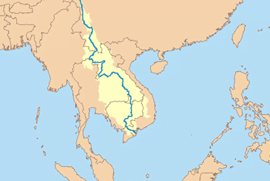(Phnom Phen, Cambodia) – The mighty Mekong River spanning Southeast Asia has won reprieve from a planned $3.8 billion hydro-electric dam project in Laos — for now. Meeting in Northern Cambodia last week, representatives from Thailand, Cambodia, Vietnam and Laos (perhaps grudgingly) postponed a decision and called for further study, helmed by Japan, into its potential effects on the Mekong ecosystem.
The other Mekong-river nations willingness to stop the 1,260 mega-watt dam is rooted in both conservationist sentiment and in self-interest. Although tiny Laos has claimed the dam won’t affect nations downstream, no one is buying it: it’s impossible to deny a huge project at the headwaters of a major river will have serious ecological effects.
According to groups such as the Mekong River Commission and International Rivers, the Xayaburi dam would almost inevitably cause serious damage to fish stocks and wreck havoc on the normal tidal movement of the river—and perhaps impede future water availability to other nations with planned dam projects of their own.
Further, some fear the building of one profitable dam will set off a chain reaction of damn building. Laos has 8 other damming projects in mind beside the Xayaburi, and according to the BBC, Cambodia has projects of its own in the works.
A lot of money is at stake here. Laos would like to position itself as the “battery” of Southeast Asia, while Thailand (which only a small portion of the Mekong runs through) has already agreed to purchase 95 percent of the energy generated. The fate of downstream states Cambodia and Vietnam, to these two players, has very little weight in the equation.
The real losers would be poor farmers and fisher-people in Vietnam and Cambodia, living along the Mekong and in the river delta, who depend heavily both on healthy fisheries and a predictable river-system. One need only look at the Nile or Colorado rivers to see how this story played out in the past.
As conservation groups have pointed out—and as officials from Mekong River nations seem to agree— too little is known about how dams will affect the Mekong to consider such a project before more good research has taken place. But last week’s stay of the Xayaburi project doesn’t mean the Mekong is safe. Even if this project gets canned, the damming and ecological destruction of the Mekong seems almost inevitable, as Southeast Asia propels itself into the world economy.
Protecting the Mekong should be a major priority for Southeast Asia. It is a relatively pristine river—and one of the last such major river systems mostly unaffected by industrial development and large-scale dam. Allowing Lao’s immediate needs to ruin the Mekong strikes me as pure avarice.
It’s easy to find examples of ecological ruin stemming from poorly-thought out dams: The Mississippi River’s dams in the USA stopped the flow of sediment downstream to the sea, destroying the wetlands that protected New Orleans—making the 2005 Katrina hurricane that much more deadly. China built the Three Gorges Dam in the name of flood prevention and power—a dam that displaced millions, eroded land downstream, destroyed fisheries, and allowed industrial pollutants into the water, among other flaws. It was only this year that China acknowledged “problems” existed with the monolithic project.
These are mistakes Southeast Asia can avoid, if there is political will.
Development is both inevitable and needed, especially for impoverished and power-starved Laos, but dooming an economically vital ecosystem in the name of financial gain is no long-term solution.

